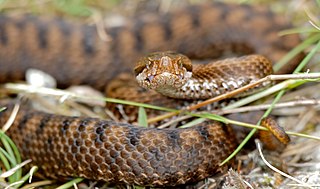
Cerastes cerastes, commonly known as the Saharan horned viper or the desert horned viper, is a venomous species of viper native to the deserts of Northern Africa and parts of the Arabian Peninsula and Levant. It is often easily recognized by the presence of a pair of supraocular "horns", although hornless individuals do occur. Three subspecies have been described.

Echis carinatus, known as the saw-scaled viper, Indian saw-scaled viper, little Indian viper, and by other common names, is a viper species found in parts of the Middle East and Central Asia, and especially the Indian subcontinent. It is the smallest member of the "big four" Indian snakes that are responsible for causing the most snakebite cases and deaths, due to various factors including their frequent occurrence in highly populated regions, and their inconspicuous nature. Like all vipers, the species is venomous. Two subspecies are currently recognized, including the nominate subspecies described here.

Echis coloratus, known as the painted saw-scaled viper, painted carpet viper, Burton's carpet viper, and by other common names, is a highly venomous viper species endemic to the Middle East and Egypt. No subspecies are currently recognized.

The four venomous snake species responsible for causing the greatest number of medically significant human snake bite cases on the Indian subcontinent are sometimes collectively referred to as the Big Four. They are as follows:
- Russell's viper, Daboia russelii
- Common krait, Bungarus caeruleus
- Indian cobra, Naja naja
- Indian saw-scaled viper, Echis carinatus

Echis megalocephalus, also known commonly as the big-headed carpet viper and Cherlin's saw-scaled viper, is a species of venomous snake in the family Viperidae. The species is endemic to one island in the Red Sea off the coast of Eritrea. There are no subspecies that are recognized as being valid.

Echis is a genus of vipers found in the dry regions of Africa, the Middle East, India, Sri Lanka and Pakistan. They have a characteristic threat display, rubbing sections of their body together to produce a "sizzling" warning sound. The name Echis is the Latin transliteration of the Greek word for "viper" (ἔχις). Like all vipers, they are venomous. Their common name is "saw-scaled vipers" and they include some of the species responsible for causing the most snakebite cases and deaths in the world. Twelve species are currently recognized.

Vipera aspis is a venomous viper species found in southwestern Europe. Its common names include asp, asp viper, European asp, and aspic viper, among others. Bites from this species can be more severe than from the European adder, V. berus; not only can they be very painful, but also about 4% of all untreated bites are fatal. The specific epithet, aspis, is a Greek word that means "viper." Five subspecies are currently recognized, including the nominate subspecies described here.

Echis hughesi, known as the Hughes' carpet viper, Somali carpet viper, and Hughes' saw-scaled viper, is a species of venomous snake in the subfamily Viperinae of the family Viperidae. The species is endemic to Somalia. There are no subspecies which are currently recognized as being valid.
Echis jogeri, known as the Joger's carpet viper, Mali carpet viper, Joger's saw-scaled viper, is a species of venomous snake in the family Viperidae. The species is endemic to Mali. There are no subspecies which are recognized as being valid.

Echis leucogaster, also known as the white-bellied carpet viper or the Roman's saw-scaled viper, is a viper species endemic to West and Northwest Africa. Its scientific name derives from its white (leuco-), unmarked belly (gaster). like all other vipers, it is venomous. No subspecies are currently recognized.
Echis ocellatus, known by the common names West African carpet viper and ocellated carpet viper, is a highly venomous species of viper endemic to West Africa. No subspecies are currently recognized.

Echis pyramidum, known as the Northeast African carpet viper, Egyptian saw-scaled viper, and by other common names, is a species of viper endemic to Northeast Africa and the Arabian Peninsula. Like all other vipers, it is venomous. Three subspecies are currently recognized, including the nominate subspecies described here.

Echis carinatus multisquamatus is a venomous viper subspecies found in Uzbekistan, Turkmenistan, Iran, Afghanistan, and Pakistan.
Echis carinatus sinhaleyus is a venomous viper subspecies endemic to Sri Lanka.

Echis carinatus sochureki is a venomous viper subspecies found in India, Pakistan, Afghanistan, Iran, and parts of the Arabian Peninsula.
Echis pyramidum leakeyi is a venomous viper subspecies endemic to northern East Africa.

The fiery flying serpent is a creature mentioned in the Book of Isaiah in the Tanakh.

Echis omanensis, commonly known as the Oman saw-scaled viper, is a species of viper. Like all other vipers, it is venomous.

Echis borkini is a species of viper. Like all vipers, it is venomous. It was originally described as subspecies of Echis varius.















